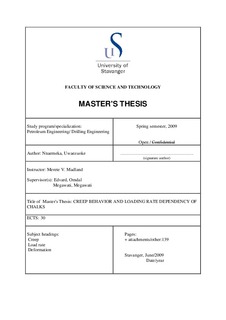| dc.description.abstract | ‘‘Mechanically high porosity chalks behave as frictional materials, but with an end-cap
reflecting pore collapse failure, and the mechanical properties of chalk are strongly dependent
on the type of fluid in the pores’’ [Risnes, R. (2000)]. Any applied axial load would lead to a
deformation of the sediments by the depletion of the pore fluids. This results in compaction
which is a process in which the compressive strength of the rock is exceeded and plastic
deformation occurs, resulting in irreversible reduction of porosity. Compaction is a natural
consequence of pore pressure depletion. However, it has been observed that there exists
another kind of deformation that takes place when the state of stress in the rock skeleton is
kept constant. This is known as creep and it is a time-dependent deformation which may
cause a delay in deformation response under varying load conditions.
In a producing field, creep is a result of interruption of loading. In other words, when
production is interrupted in a field, strains continue to occur [creep], but this strain depends on
the rate of production of the reservoir fluids. When a reservoir is taken into production, the
rate of change of the effective stress exerted on the reservoir rock is suddenly increased from
that imposed by the burial process over a geologic time span, to that induced by the depletionpressure
history. This change in loading rate will have a large influence on the in-situ
compaction behavior if the rate effects observed at laboratory loading rates also occur at
geological and depletional loading rates [de Waal, J. A., Smits, R. M. M. (1988)]. In
carbonates [chalk], creep is common and how the rate of loading affects creep and creep rate
is then investigated. The tests for creep in this thesis are performed under drained conditions
[constant pore pressure].
Core samples were taken to overburden, confining and pore pressures. The pore pressure was
then depleted from the initial state to a certain value. This reduction results in an increase in
the effective stresses, which then activates a certain behavior of the chalk grains. It is believed
that the behavior of the grains is affected by the rate at which the stress is increased. Hence,
samples are loaded both rapidly and slowly and deformation and other parameters are thereafter compared. Intermediate loading rate between the rapid and slow loading rates is
also included to investigate the behavior towards the two extremes.
A reduction from 30 MPa to 5 MPa pore pressure in 100 minutes [0.25 MPa/min] was termed
rapid loading. The same pressure was depleted for about 8333 minutes [0.003 MPa/min] and
ii
regarded as a slow loading. At the lower limit of 5 MPa, the samples were left to deform
under constant stress for some time. This is known as time-dependent deformation or creep.
It was observed that when loaded rapidly, the deformation accumulated at the creep stage is
more [mainly at the transient creep phase] compared to when loaded slowly.
Generally, the result of the experiments in this thesis shows that other parameters such as
uniaxial compaction modulus both in the elastic and plastic regions, yield stress, creep strain
and creep rate, stress path etc are all loading rate dependent. Also included are porosity versus
mean effective stress [pore pressure] charts, and axial differential stress versus mean effective
stress chart. | no_NO |
